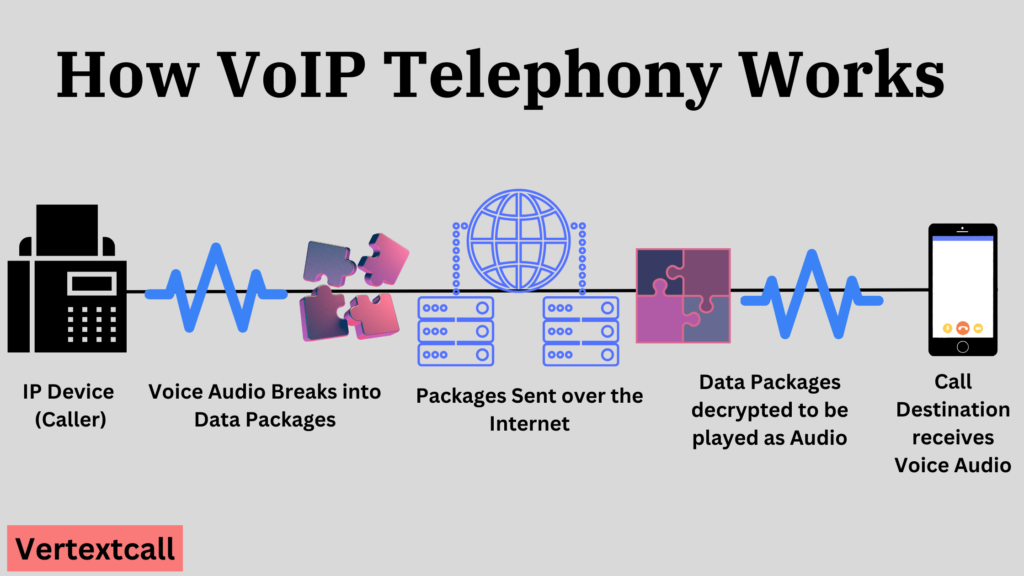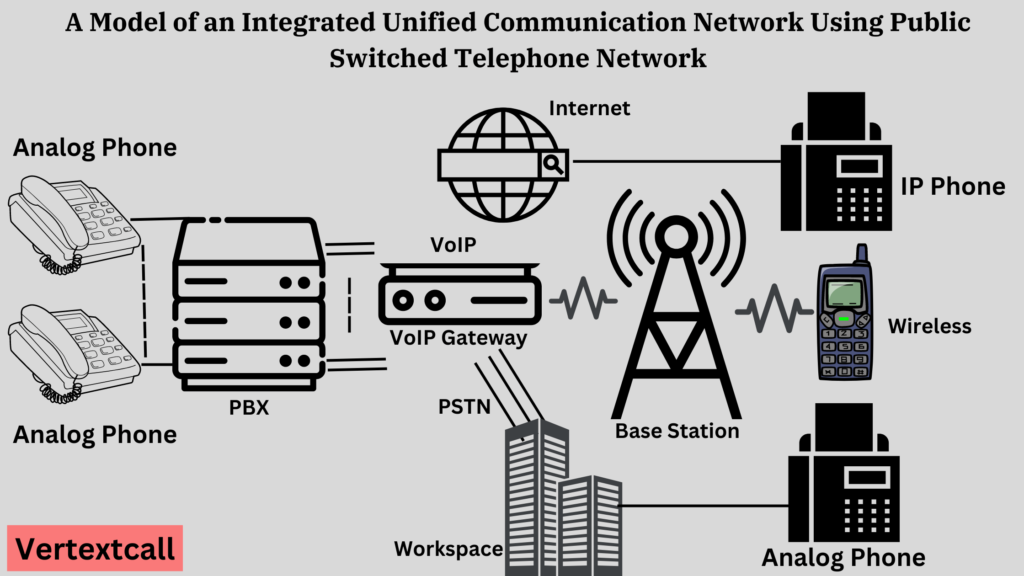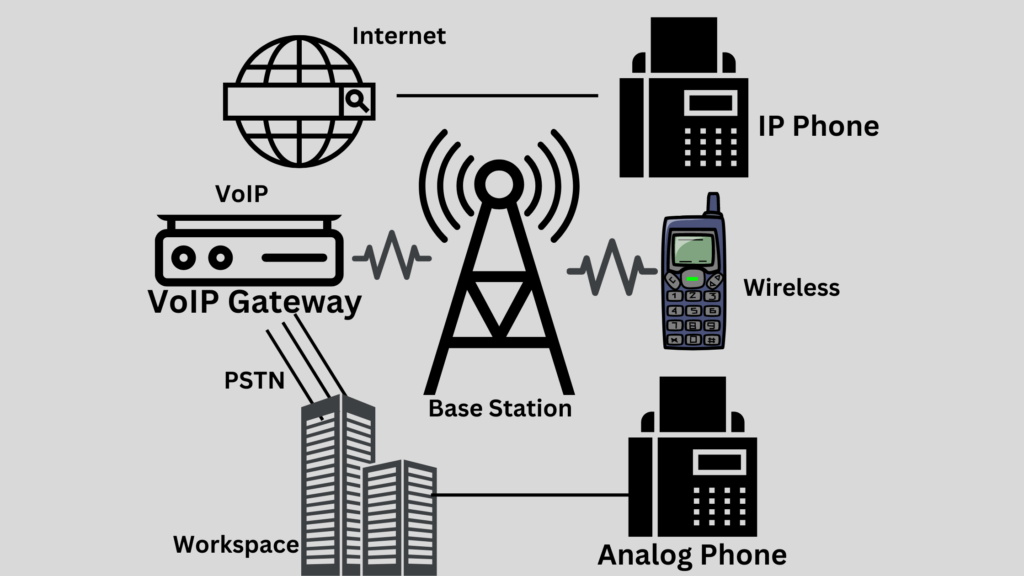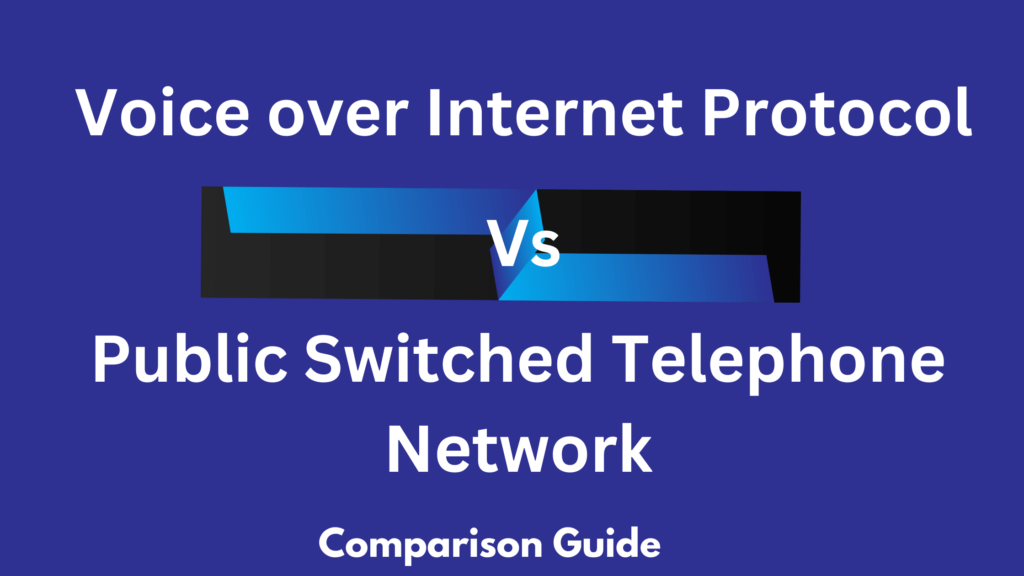In a rapidly evolving digital ecosystem, the communication infrastructure of your business is more critical than ever. The question for many businesses now stands: Should you go with a traditional Public Switched Telephone Network (PSTN), or is it time to switch to Voice over Internet Protocol (VoIP)?
In this post, we’ll explore the differences between the two and help guide you toward making an informed decision for your enterprise.
Table of differences between VoIP and PSTN
This table provides a clear overview of the differences between VoIP and PSTN, covering key aspects such as transmission, infrastructure, quality, cost, features, flexibility, reliability, security, and regulatory compliance.
Feature | VoIP (Voice over Internet Protocol) | PSTN (Public Switched Telephone Network) |
Transmission | Digital | Analog |
Infrastructure | Packet-switched | Circuit-switched |
Data Transfer | Uses existing internet infrastructure | Requires dedicated lines |
Quality | Can vary depending on internet quality | Standard |
Cost | Generally lower, especially for long-distance calls | Higher due to dedicated lines |
Features | Rich features like video calls, conference calls, instant messaging | Basic voice services |
Flexibility | High, can be used anywhere with internet access | Limited |
Reliability | Dependent on internet connectivity, At risk to outages if internet fails | Resilient against power outages and disasters |
Security | Vulnerable to hacking and eavesdropping, requires additional security measures | Analog lines are inherently secure |
Regulatory Compliance | Varied regulations across jurisdictions, E911 compliance may be challenging | Compliance with telecommunication regulations |
What is VoIP
VoIP, short for Voice over Internet Protocol, represents a significant shift in telecommunication strategies. By using high-speed internet, VoIP technology transmits voice data digitally.
Unlike the PSTN, which relies on dedicated circuit-switched networks for each call, VoIP converts voice signals into data packets that travel diverse paths across the internet to their destination.
This enables you to make calls from smartphones, computers, and VoIP-enabled desk phones, offering a range of communication possibilities.
VoIP comes with enhanced features like automated attendant, call recording, and video conferencing. VoIP is both innovative and adaptable to a range of business needs, reinforcing its growing preference among modern enterprises. In fact, by 2030, the mobile VoIP market is forecasted to achieve a valuation of US$913.2 Billion.

How VoIP Works
Here’s a detailed breakdown of how VoIP works:

- Digital Conversion: VoIP starts communication by converting analog voice signals into a digital format, making it easier to transmit over the internet.
- Packet Transmission: The voice signal is then divided into packets of digital data, which are sent over the internet using Internet Protocol (IP).
- Routing via IP: These packets find the most efficient path to their destination, ensuring fast and reliable transmission.
- Reassembling the Signal: At the receiving end, the packets are rearranged sequentially to restore the original voice signal
- Decoding: The digital signal is then converted back into an analog voice signal, ready for the receiver to hear.
VoIP technology works seamlessly on various devices, including VoIP phones, traditional phones with adapters, computers, and mobile devices. In addition to voice calls, VoIP integrates additional features like video calls, text messaging, and fax, all through the same internet-based platform.
Key components of VoIP
1/ Codec: Codecs encode and decode voice signals into digital packets, balancing audio quality and bandwidth usage for optimal performance.
2/ IP Phones: These devices resemble traditional phones but connect directly to IP networks using Ethernet or Wi-Fi.
3/ Softphones: Software-based phone systems installed on computers or mobile devices enable voice communications through internet connections.
4/ ATA: Analog Telephone Adapters convert analog signals to digital data, allowing conventional phones to be used for VoIP.
5/ SIP: Session Initiation Protocol is the standard communication protocol for initiating and managing VoIP connections.
6/ Quality of Service (QoS): Network routers and switches with QoS settings prioritize VoIP traffic to prevent call decline or interruptions.
7/ RTP: Real-time Transport Protocol delivers audio and video over IP networks, ensuring timely packet delivery.
8/ Network Bandwidth: Sufficient network capacity is crucial for VoIP quality, and handling voice packets without delay.
9/ PBX: Private Branch Exchange systems are internal telephone networks used within a company, switching calls between VoIP on local lines while allowing users to share external phone lines.
Related Reading: Business VoIP vs PBX
These key components work together to enable the transmission of voice data over IP networks, supporting various features and functionalities essential for VoIP communication.
Why do businesses prefer VoIP over PSTN?
Businesses increasingly prefer (VoIP) over traditional (PSTN) due to many compelling reasons:
- Cost Efficiency: When compared to traditional PSTN systems, VoIP offers significant cost savings of up to 50%, particularly for international communication. By utilizing the power of the internet, VoIP eliminates the need for expensive long-distance charges, resulting in lower monthly bills and increased cost efficiency.
- Added Flexibility: One of the key advantages of VoIP services is the ease of adding new numbers and lines. With VoIP relying on internet connectivity, your business can effortlessly expand its communication capabilities without the hassle of physical infrastructure. This added flexibility enables your business to adapt and grow with ease.
- Comprehensive Functionality: VoIP presents a diverse set of advanced features that improve productivity and streamline communication. These include call forwarding, conferencing, voicemail-to-email, and more. These powerful tools enable businesses to improve efficiency and collaboration, providing the necessary resources for success.
- Enhanced Scalability: As your business grows, its communication needs evolve too. VoIP offers seamless scalability, enabling your business to effortlessly and cost-effectively expand its communication infrastructure. Whether it’s adding new employees or opening new branches, VoIP can scale alongside the business, ensuring consistent and reliable communication.
- Mobility: VoIP enables you to make and receive calls from anywhere, at any time, using any device with an internet connection. This freedom from location and device restrictions facilitates remote work, increases productivity, and provides unparalleled mobility in the dynamic business environment.
What is PSTN in simple terms?
The PSTN, or Public Switched Telephone Network, is the traditional telephony system that relies on circuit-switched networks operated by national, regional, or local telecommunication carriers.
It’s a network of physical cables, switches, and satellites facilitating voice communication for over a century. PSTN operates on the principle of dedicated circuits – a continuously open connection or path reserved for the duration of a call between two points.
In a PSTN framework, voice is transmitted through a series of conversions. Initially, auditory signals are converted to electrical signals via a telephone handset. These signals are then often converted again for transmission over digital networks using a process called digitization. At the receiving end, these transformations are reversed to deliver audible speech.
How does PSTN work
A step-by-step explanation of how PSTN works:

- Call Initiation: When a traditional telephone makes a call, an electrical current travels through the handset’s circuit, initiating the dialing process.
- Signal Transmission to Local Exchange: The electrical signal is sent to a local exchange via copper wires. Local exchanges, like telephone hubs, are the first point of contact in the routing process.
- Conversion and Digitisation: If the infrastructure supports it, analog signals are converted to digital using Pulse Code Modulation (PCM) for more efficient long-distance communication.
- Circuit Establishment: A dedicated circuit is established between the caller and receiver through a network of switches and exchanges. This direct link remains open exclusively for the duration of the call.
- Routing Through the Network: The dedicated circuit can be routed through local, national, or international exchanges using copper wires, fiber optic cables, microwave transmission towers, and satellites.
- Completion of Call Connection: Once the route reaches the receiver’s local exchange, the signal is directed to the final telephone line. Here, digitized signals are converted back to analog if necessary for the receiver’s phone to process.
- Communication Phase: The open circuit allows for two-way communication between the caller and receiver, with voices transmitted as an uninterrupted analog signal over the established pathway.
- Call Termination: When the call is completed, the connection between the caller and receiver is severed, freeing up the circuit. The switches reset, ready to establish new connections for subsequent calls.
Related Reading: Call termination meaning
In short, PSTN operates on a circuit-switched architecture, utilizing analog signals, central offices, switches, trunk lines, and signaling systems to facilitate voice communication between subscribers.
While traditional PSTN technology continues to serve as the foundation of telecommunications infrastructure, it is gradually being replaced by digital technologies like Voice over Internet Protocol (VoIP) for its cost-effectiveness, scalability, and advanced features.
Components of PSTN
1/ Local Loops: A local loop refers to the physical wire or fiber cable that connects your telephone to the local exchange or switch. It’s what allows you to access the telephony network.
2/ Central Office Switches: These are the essential switching systems located within a central office (CO) that route your calls to the right destination. They play a crucial role in establishing and maintaining your telephone connections.
3/ Trunk Lines: Trunk lines are communication pathways that connect switches in different locations. They serve as the backbone of the PSTN and handle multiple simultaneous transmissions between offices.
4/ Signaling Systems: Signalling systems are protocols used to control call setup and teardown within the network.
5/ International Gateways: Gateways act as access points for international voice traffic, connecting domestic and overseas networks. They consist of routing systems capable of various functions, including signaling, call translation, and network integration.
6/ Satellites and Microwave Towers: For areas where it’s impractical to connect with cables, communication is made possible through satellites and microwave towers.
What are the disadvantages of PSTN?
Public Switched Telephone Network does come with several disadvantages, especially when compared to technologies like Voice over Internet Protocol (VoIP). Here are some of the key disadvantages of PSTN:
1/ Limited Scalability: When businesses expand, scaling up PSTN systems can become a hassle and a drain on resources. Adding new lines often requires physical wiring and additional hardware, which can be problematic for rapidly growing operations.
2/ High Maintenance Costs: PSTN infrastructure relies on outdated technology that requires regular maintenance. The costs associated with maintaining copper lines and exchanges are considerable and ultimately passed on to consumers.
3/ Lack of Advanced Features: Compared to modern VoIP solutions, the traditional PSTN system offers limited features. Functions, like call forwarding, caller ID, and voicemail, are often considered add-ons that may come with extra charges.
4/ Inflexibility in Number Porting: Moving a business location can result in significant challenges with number portability. Geographic restrictions often mean that your business cannot retain the same phone number when relocating.
5/ Dependence on Physical Infrastructure: PSTN’s reliance on physical networks makes it exposed to environmental factors and potential service outages. Natural disasters, for example, can cause extensive damage to the physical lines, leading to sustained communication disruptions.
6/ Environmental Impact: The extensive use of copper and other materials in PSTN’s physical infrastructure contributes to environmental degradation. Moreover, the significant energy consumption required for network maintenance adds to environmental concerns.
PSTN example
Consider a small business with a customer service center that heavily relies on PSTN for its daily operations. They use PSTN lines for order placements, support calls, and daily communication needs. When customers dial the company’s publicly listed PSTN number, the call travels through copper wires to the local exchange. Here, the signal passes through switches to ensure clear and uninterrupted voice communication throughout the call.
How does VoIP connect to PSTN?
VoIP (Voice over Internet Protocol) technology integrates with the Public Switched Telephone Network (PSTN) through advanced components called VoIP gateways. These gateways play a crucial role in merging internet-based and traditional telephony environments.

They convert the digital packets used in VoIP into analog signals for outgoing calls on PSTN, and vice versa for incoming calls. This smooth conversion allows you on VoIP networks to communicate effortlessly with those on PSTN, ensuring compatibility and uninterrupted service across different communication frameworks.
This functional synergy enables businesses to leverage VoIP’s cost-efficiency and advanced features while maintaining connectivity to the prevalent PSTN.
Key differences between VoIP and PSTN
Voice over Internet Protocol and Public Switched Telephone Network each has its own set of characteristics and infrastructure. Below, we outline the key differences between the two:
1/ Technology Foundation: VoIP is built on digital packet-switched networks, where voice communications are converted into data packets and transmitted over the internet. On the other hand, PSTN relies on analog signals sent over copper wires in circuit-switched networks.
2/ Infrastructure Requirements: VoIP can operate over existing data networks, eliminating the need for separate telephony cabling. PSTN requires a dedicated network of copper lines, switches, and other hardware, which can be costly and inflexible.
3/ Cost Effectiveness: VoIP often offers significant cost savings by leveraging internet connectivity, and providing free or low-cost calls, particularly for international calls. PSTN typically incurs higher charges due to maintenance of its extensive physical infrastructure, especially for long-distance calls.
4/ Scalability: VoIP easily scales with business growth, allowing the addition of lines or extensions with minimal effort, often through software configurations. PSTN scalability can be difficult, typically requiring the physical installation of new lines and hardware.
5/ Feature Richness: VoIP inherently supports a wide range of features such as video calls, file sharing, and instant messaging, integrated within the communications platform. PSTN offers a more limited set of features, with additional functionalities often incurring extra costs.
6/ Mobility and Flexibility: VoIP enables you to place and receive calls with an internet connection despite your location, providing mobility and adaptability. PSTN services are generally fixed to one location, limiting mobility.
7/ Resilience and Continuity: VoIP networks can implement backup mechanisms, contributing to greater service continuity. PSTN, heavily dependent on physical infrastructure, may experience service disruptions due to environmental damage or technical failures.
8/ Quality of Service: Although VoIP has significantly improved, PSTN still leads in providing consistent high-quality voice transmission, especially in areas with variable internet service.
9/ Environmental Impact: VoIP is considered more environmentally friendly due to its use of existing data networks and associated reduction in material use. PSTN’s reliance on a vast network of copper wiring has a greater environmental footprint.
Difference between VoIP lines and PSTN lines
When considering VoIP and PSTN lines, you can think of them as two different paths for your voice to travel during a phone call. PSTN lines are like the traditional phone lines we’ve used for decades — they rely on physical cables and specific pathways to carry calls from one telephone to another. These lines are dedicated solely to voice communication and have been around since the early days of telephony.
VoIP lines, however, are a more modern route. They send your voice over the internet in the form of data, much like how your email goes from your computer to another device. As discussed above with VoIP, your voice is converted into digital information that can travel over the broadband internet connection you use for emailing, browsing the web, and streaming videos. This technology is not bound to a single physical route and can integrate voice calls with other forms of digital communication, such as video calls and messaging.
Reliability of VoIP protocols VS PSTN
VoIP’s reliability has always been a topic of intense analysis, especially compared to PSTN’s tried-and-true resilience. VoIP protocols like Session Initiation Protocol (SIP) and Real-time Transport Protocol (RTP) are designed to facilitate multimedia and voice communications over IP networks.
These protocols include packet retransmission and jitter buffers to address challenges like packet loss and delay inherent in IP-based communications. However, the reliability of VoIP depends on the stability and quality of the core internet connection.
Employing diverse paths for data transmission in VoIP can enhance reliability and provide redundancy, but this relies on a network infrastructure capable of detecting and rerouting traffic in case of failures.
In contrast, PSTN’s circuit-switched technology, established over a century ago, offers a high level of inherent reliability and quality. The network is built with redundancy, ensuring a service continuity standard that is unmatched, especially in areas with limited internet infrastructure.
Moreover, PSTN providers are often required to maintain a certain level of service quality and availability due to regulatory requirements, further reinforcing its reputation for reliability.
PSTN Vs ISDN VS VoIP
This table provides a concise comparison of the key features and characteristics of PSTN, ISDN, and VoIP technologies, enabling you to understand the differences between them easily.
Features of Differentiation | PSTN (Public Switched Telephone Network) | ISDN (Integrated Services Digital Network) | VoIP (Voice over Internet Protocol) |
Transmission | Analog | Digital | Digital |
Infrastructure | Circuit-switched | Circuit-switched | Packet-switched |
Data Transfer | Dedicated lines | Dedicated lines | Uses existing internet infrastructure |
Quality | Standard | Higher than PSTN, lower than VoIP | Can vary depending on internet quality |
Cost | Higher due to dedicated lines | Moderate | Generally lower, especially for long-distance calls |
Features | Basic voice services | Additional features like video conferencing, faster data transfer | Rich features like video calls, conference calls, instant messaging |
Flexibility | Limited | Moderate | High, can be used anywhere with internet access |
Reliability | Resilient against power outages and disasters | More resilient than PSTN, less than VoIP | Dependent on internet connectivity, prone to outages if internet fails |
Security | Analog lines are inherently secure | More secure than PSTN, but less than VoIP | Vulnerable to hacking and eavesdropping, requires additional security measures |
Regulatory Compliance | Compliance with telecommunication regulations | Subject to regulations, often E911 compliant | Varied regulations across jurisdictions, E911 compliance may be challenging |
Future Outlook | Declining usage, gradual transition to digital | Declining due to emergence of newer technologies | Increasing popularity due to cost-effectiveness and feature-rich services |
Related Reading: Difference between ISDN and VoIP
Frequently Asked Questions
Q1) How is VoIP different from telephone lines?
Ans: VoIP differs significantly from traditional telephone lines. Instead of using circuit-switched networks like the Public Switched Telephone Network (PSTN), VoIP utilizes digital packet-switched networks. Unlike traditional phone lines that transmit voice through analog signals over dedicated copper wires, VoIP transforms voice into data packets, transmitting them across the Internet. This internet-based approach allows for the transmission of various types of data, making communication more versatile.
Q2) Is VoIP cheaper than PSTN?
Ans: VoIP generally provides a more cost-effective alternative to PSTN, particularly when considering infrastructure and operational expenses. By utilizing existing internet connections, VoIP typically results in lower costs, especially for international calls. In contrast, PSTN incurs higher expenses due to maintaining and expanding its physical network, as well as the inherent costs associated with long-distance calls made through its platform.
Q3) Who is the provider of PSTN?
Ans: The PSTN is typically provided by national and international telecommunication service providers, often referred to as legacy carriers or incumbent operators. They are responsible for maintaining the extensive network of telephone lines, exchanges, and infrastructure that make up the traditional telephone system still widely used in many parts of the world.
Q4) What is the difference between SIP and PSTN?
Ans: SIP utilizes the Internet to transmit calls as data packets, offering greater flexibility and features such as video conferencing and instant messaging. On the other hand, PSTN is the traditional network that carries analog voice data through circuit-switched telephony. While PSTN is widely used and highly reliable, SIP offers greater flexibility and can support a wide range of new services and integration with other protocols.
Q5) Does VoIP need PSTN?
Ans: No, VoIP does not necessarily require the PSTN to function. However, to maintain connectivity with users who still use traditional phone systems, VoIP services can interface with the PSTN. This compatibility is facilitated through VoIP gateways, which convert analog voice signals to digital formats and vice versa, thereby enabling communication across diverse network technologies.

